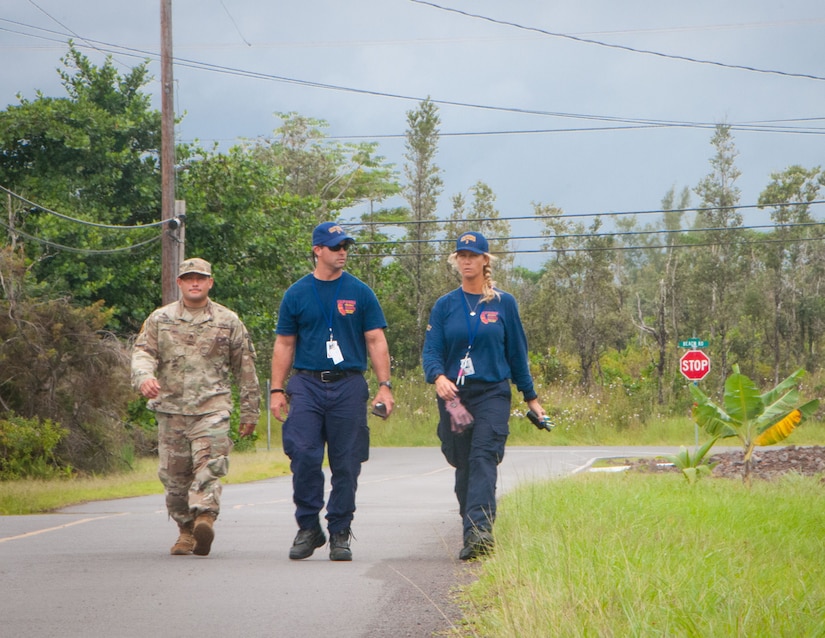By Air Force Senior Airman Robert Cabuco, State of Hawaii
Department of Defense
KEAUKAHA, Hawaii -- Just when Hawaii National Guard leaders
thought they could begin to transition their personnel away from the disaster
response mission that formed in the wake of Kilauea’s eruption, Task Force
Hawaii was bombarded by Hurricane Lane, Aug. 22-26.
Since the start of Kilauea's eruption in early May, more
than 150 service members from the Hawaii Army and Air National Guards have
assisted Hawaii County authorities in keeping evacuated neighborhoods safe. By
August, the lava flow had momentarily subsided and TF Hawaii was preparing to
wrap up the operation.
“We were expecting it to be a pretty quiet rotation,” said
Army 1st Sgt. Mark Tiwanak, from Bravo Company, 777th Aviation Battalion. “We
take over steady-state [operations] and we slowly close down the operation.
Should be a nice quiet mission, that’s what we were expecting. We were in the
process [of] learning the operations ... when we received the hurricane
warning. I knew right away I needed to identify my command team and develop
communications through the ranks within a short time frame.”
Disaster Response
The response to any disaster is tiered. Phase One is
prepare, Phase Two is response, and Phase Three is recovery. Once recovery is
accomplished, first responders move back to prepare. With most disasters, the
response is brief and the transition to recovery quick. The thing that
separates the Kilauea eruption from most disasters is the time first responders
have spent in the response phase. The lava response has lasted four months, and
the county and state, along with the Hawaii National Guard, were ready to move
to the recovery phase when Hurricane Lane approached the state.
In addition to the challenge of taking over operations, TF
Hawaii was faced with the additional threat of Hurricane Lane and had to
quickly change gears to prepare for the worst. Anticipating emergency responses
in Kona, on the other side of the island, TF Hawaii divided its personnel and
sent one of its three response teams to cover the area.
During the lava support mission, TF Hawaii ran 24-hour
operations, the team was split into three, eight hour shifts. Because of the
hurricane they were now divided into two teams performing 12-15 hour shifts,
further straining the service members.
“I had to figure out who were going to be the key players in
carrying out the mission,” Tiwanak said. “I selected team leads that were local
to the Big Island and were familiar with the surrounding environment, so they
can quickly deploy to the locations where emergency support was required.”
Hurricane Lane
When the outer bands of the hurricane reached Hawaii, it
dropped 52 inches of rain in two days, resulting in widespread flooding. TF
Hawaii responded to rescue missions in the Hilo area. These requests for
support came primarily from the Hawaii Fire Department, whose resources were
wearing thin. The fire department had also been supporting the island
communities during the lava threat.
“We were called to Waianuenue, but half my team was from
Honolulu and it would take longer to get there,” said Army Staff Sgt. Gregory
Lum Ho, from Bravo Company, 777th Aviation Support Battalion. “Half my team
remained in Pahoa, and we answered the call for help. I reported to a [Hawaii
Fire Department] battalion chief, Michael Hayashida, and with our vehicles and
their firemen we were able to rescue a couple on one mission, and returned to
rescue their extended family of four and their dog.”
The flooding created dangerous situations across the island.
On many roadways, the water levels rose to 3-4 feet, stranding vehicles
in-place.
Rescues
“Our first rescue involved a 61-year old man stuck in his
truck in a pool about four feet deep,” said Staff Sgt. Jonathan
Anderson-Leonard, from the Hawaii Air National Guard’s 169th Air Defense
Squadron Security Forces. “[The Hawaii Fire Department] rescued the individual
and we transported him to base ops.” Anderson-Leonard said he went on to
perform two more vehicle rescues that same evening.
The extraordinary efforts performed by service members in
conjunction with the extended shifts placed a heavy burden on the military
personnel. Their well-being was a high priority for Army Chaplain (Maj.) Ray
Kitagawa.
“I have served this mission on three separate engagements
since it started,” said Kitagawa. “I help check on troop morale and ethics as
well as help [the] command make decisions involving civilians.”
Kitagawa said he made daily visits to the checkpoints to see
how the troops were faring. He brought with him snacks and goodies and was
often welcomed with smiles.
“During the storm, we prayed daily for our troops,” he said.
“It was a pleasure to serve the people of this community as well as the state
and this island. I was born and raised here, so it feels good to give back to
people that I know and love.”

No comments:
Post a Comment